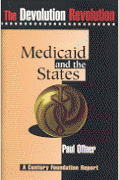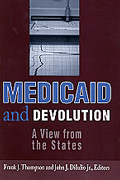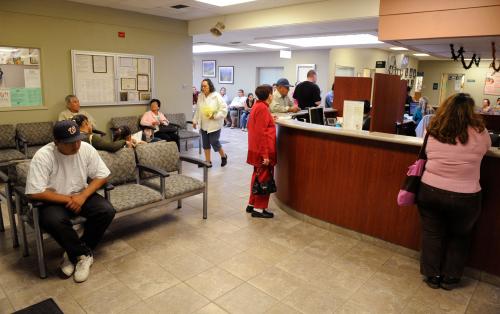What’s the latest in health policy research? The Essential Scan, produced by the USC-Brookings Schaeffer Initiative for Health Policy, aims to help keep you informed on the latest research and what it means for policymakers. If you’d like to receive the biweekly Essential Scan by email, you can sign up here.
New 340B Markets Associated with Increase in Cancer Drugs Administered in Hospital Outpatient Departments versus Physician Offices
Study by: Jeah Jung, Wendy Y. Xu, and Yamini Kalidindi
The 340B federal drug pricing program, which provides substantial discounts for most outpatient prescription drugs to eligible health care organizations, was originally intended to provide financial support to hospitals and federal grantees serving low-income and uninsured patients. Since it was implemented in 1992, the program has grown substantially due to an eligibility expansion attached to the ACA as well as an increase in the number of community-based clinics joining the program through either affiliating or merging with a 340B hospital. However, many are concerned that the program creates financial incentives for 340B hospitals to change practice patterns to maximize the population receiving 340B drugs without using the increased revenue from the associated 340B subsidies to benefit low-income patients. A new study analyzes the impact of the program on the site of cancer drug administration and levels of cancer care spending in Medicare by using a difference-in-differences model to look at care patterns in markets with and without 340B hospitals following the ACA’s expansion of the program. The researchers find the probability of a patient receiving cancer drug administration in hospital outpatient departments versus physician offices increased 7.8 percentage points in new 340B markets compared to markets with no 340B hospital. This corresponded to an increase in per-patient spending on other cancer care of $1,162 in new 340B markets. However, the researchers found no significant effect of the 340B program on use or spending on provider-administered cancer drugs. These results suggest policymakers should closely monitor the effects of the program on overall service use and spending. Full study here.
Medicaid Expansion Does Not Discourage Work
Study by: Lizhong Peng, Xiaohui (Ronnie) Guo, and Chad D. Meyerhoefer
Since the passage of the Affordable Care Act in 2010, one of the most controversial parts of the law has been the state-level expansion of the Medicaid program. Opponents of Medicaid expansion argue that providing a guarantee of health insurance to more able-bodied adults will create a “powerful work disincentive.” The idea that Medicaid enrollment discourages work has led to an increasing number of states seeking approval from CMS for waivers to impose work requirements on their Medicaid enrollees, with support from CMS Administrator Seema Verma. However, a new study suggests that while Medicaid expansions lowered employment rates by 1.3 percent in the year immediately following expansion, the effect dissipated in the following years. Unlike previous studies that were only able to compare state-level changes in labor market outcomes, this new study uses a differences-in-differences model to examine pairs of counties that border each other but belong to different states-which greatly improves the comparability of the treatment and control groups. The results of this study suggest that Medicaid expansion does not create a significant disincentive to work, but rather might allow those with the greatest disutility from work (possibly due to the presence of chronic conditions) to leave the labor force before being quickly replaced and gives workers the flexibility to re-sort themselves into different jobs. Full study here.
Medicaid Expansion Not a Major Factor in Opioid Crisis
Study by: Atheendar S. Venkataramani and Paula Chatterjee
As the opioid crisis has worsened and gained increasing attention from policymakers and the public at large, many have been concerned that expanding access to Medicaid as part of the Affordable Care Act has had the unintended consequence of expanding access to the highly addictive opioid painkillers that have greatly exacerbated the crisis. In an attempt to isolate the effect of Medicaid expansion on opioid overdose rates, researchers examined data from Medicaid expansions that occurred in 2001 and 2002-before the opioid crisis began in earnest. The researchers found that drug overdose mortality rates rose less sharply in the three states that expanded Medicaid than in the states that did not, implying that Medicaid expansion may in fact insulate enrollees from the crisis by giving them access to substance abuse treatment programs. While this study only examines a small number of states that expanded Medicaid, these results should offer reassurance to policymakers concerned that Medicaid expansion will lead to higher rates of opioid related mortality. Full study here.
Patchwork Financing Structure of Safety-Net Hospitals Undermines Efficacy of Medicare Payment Penalties
Study by: Gloria J. Bazzoli, Michael P. Thompson, and Teresa M. Waters
In 2013, CMS implemented the Hospital Readmissions Reductions Program (HRRP) and the Value-Based Purchasing Program (VBP) to incentivize hospitals to improve outcomes and contain costs for Medicare beneficiaries. A new study examines the relationship between changes in combined HRRP and VBP penalties, and operating and total margins for different types of hospitals. They found that high-DSH (disproportionate share hospitals) and public hospitals had significantly higher payment rates relative to other hospital types. While predicted operating margins declined significantly for all hospital groups with an increase in the HRRP/VBP penalty rate, there were not statistically significant declines in total margin for these types of safety-net hospitals. This suggests that during the study period, safety-net hospitals relied on nonpatient revenues such as charitable contributions, public appropriations, government transfers, investment income, and income from subsidiaries or affiliates to fill the financial gaps created by Medicare penalties. While this may temporarily solve the problem for these hospitals, these sources of revenue are more volatile and may not be able to compensate for cumulative loss over time. Furthermore, the researchers note that if safety-net hospitals continue to patch together nonpatient care revenues to fill the gaps, these workarounds may undermine the incentives of the HRRP and VBP programs in improving outcomes and reducing costs. Full study here.












Commentary
The essential scan: Top findings in health policy research
October 18, 2018